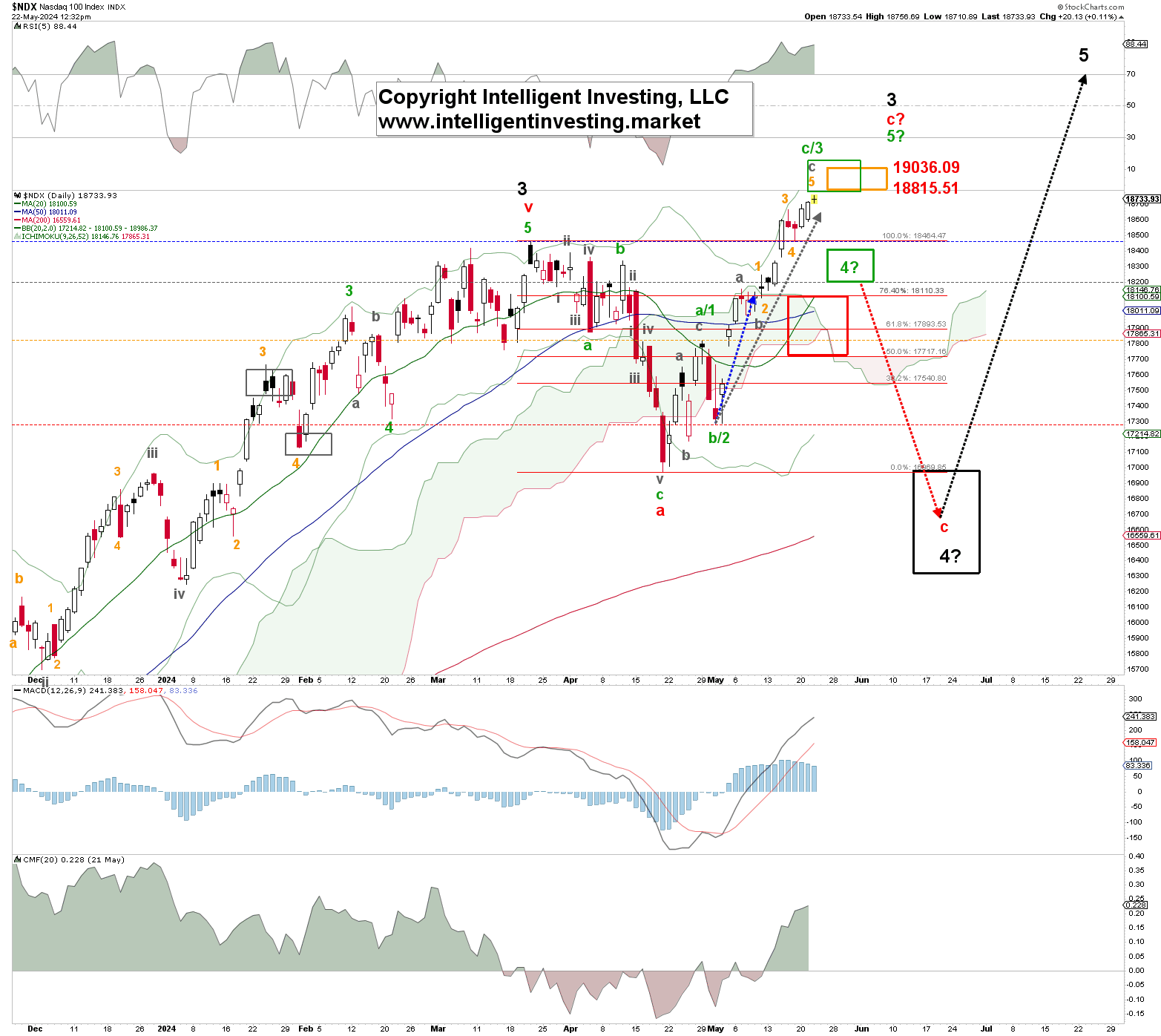In our last update from early May, we found for the Nasdaq 100 using primarily the Elliott Wave Principle (EWP):
“The current rally off the recent low counts best as a counter-trend rally [to ideally $17900-18250] and, together with seasonality, suggests the next leg lower to ideally $15900+/-500, is underway, contingent on holding below the warning levels for the Bears outlined in this article.”
Well, as they say, ”60% of the time, it works all the time” [Anchor Man], and the market stopped following the average seasonal path. Moreover, the index is now trading at around $18710. So, let's review how we have forecasted the NDX over the past month to understand better how the EWP works, how our forecasting works, and how to apply it.
In April, we had three (grey a-b-c) waves from the red W-a low into the green W-a high (see the chart below). Since the red W-a counted best as three waves lower, we knew that "after three waves down, expect at least three waves back up" because either the correction became protracted/complex (triangle or flat) or it ended with those three waves lower (zigzag). We cannot know beforehand which it will be.
Figure 1. NDX daily chart with detailed EWP count and technical indicators

However, with those initial three grey waves up into the April 29, green W-a, high, at around the 50-62% retracement (See red target box), the "at least three waves back up" leg appeared most likely completed. Moreover, we got five waves lower just before the FED announcement, as we alerted our premium members intra-day, suggesting the correction would continue after a bounce. Thus, the most probable path was for lower over the intermediate term, contingent on holding below the green W-a level. Also, seasonality supported this thesis.
The market responded to the FED announcement with three waves back up -the expected bounce- and another five waves lower to complete the green W-b as a 5-3-5. Thus, at that stage, it continued to follow our expectations, as a 1, 2, i setup, and that is why we preferred lower prices, contingent on holding at least below the FED bounce high. We viewed the "higher prices" as an alternative at that stage, but less probable does not mean impossible, and thus, we are always aware that our POV is "contingent on the market staying -in this case- below a certain price level."
Well, the market had different interventions than we preferred—no big deal, as that happens. The market signaled a protracted path by breaking above the green W-a high. If one were short, for example, that was the signal to take the loss and turn the ship to a long position. In that case, we initially look for the common c=a relationship (blue arrow). That extension would then also tag the 76.40% retracement of the red W-a—a common target for both the red W-b and the green W-c.
Just as before, we cannot know beforehand if the green W-c will extend or not, just as we cannot know beforehand if the red W-b will be regular (100%). We need to see breakdowns below the warning levels we outline daily to our premium members to know if we will get an extension or if c=a is all she will write. Thus, in this case, there's no reason to short until the warning levels are broken.
Once again, the market decided to extend, surpassing the next Fib-extension targets of 1.236, 1.382 (not shown), and even 1.618x a (grey arrow). The latter is uncommon. But uncommon does not equal impossible, and uncommon is, of course, even less likely to be known beforehand. Hence, we initially go with the more common c=a and 50-76.4% retracements. With the red W-b = W-a target exceeded, the next target zone is -just as we did for the green W-c- the "1.236 to 1.382x a" extension (orange box). If the index can stay above AT LEAST the blue -1st- warning level, it will be able to reach it, and today we’re getting close. Thus, there was still no reason to short because the indexes never broke below the warning levels. Moreover, the market hasn’t told us it has topped; thus, it can still move higher.
As you can see, once the W-a was completed, we knew we would get a counter-trend rally. We start with a common 50-76.40% retracement. When that target zone is reached in a three-wave fashion, it suggests the counter-trend rally is already over. However, we know counter-trend rallies can always extend like any other move. When that extension announces itself by a break higher, we will look for the next logical Fib-extensions and confluences (100%, 123.6%, 138.2%, etc.). When the markets fail to break below the warning levels after reaching each extension, c=a, for example, we know the next extension is on tap. We stay comfortably long while raising our stops and preferably taking partial profits until it stops working. That's how we anticipate the markets, forecast them, and trade them using the EWP and our forecasts. We hope you appreciate this explanation.
